Innovate Your Fitness Business: Personal Trainer App Development Essentials

In today’s bustling fitness industry, personal trainers face a common challenge: effectively connecting with clients, providing tailored workouts, and monitoring progress in an increasingly digital world. Traditional methods often fall short, leaving trainers and clients yearning for a more efficient, streamlined solution. This is where the power of technology steps in, offering a game-changing solution – personalized fitness apps.
Imagine empowering your trainers with a tool that enhances coaching abilities and revolutionizes how clients experience fitness. At Alternative Spaces, we recognize the transformative potential of personal trainer app development. In a world where convenience and customization reign supreme, having a dedicated fitness app isn’t just an advantage – it’s a necessity.
Table of contents
- Why Develop A Personal Fitness Trainer App
- Types of Personal Trainer Apps
- Features of Personal Training Apps
- Steps to Develop a Personal Trainer App
- The Best Ways to Monetize a Personal Trainer App
- Alternative Spaces Expertise in Personal Trainer App Development
- In conclusion
- FAQ
Our expertise lies in bridging the gap between fitness aspirations and technological innovation. We understand the unique needs of both trainers and clients, and we’ve mastered the art of crafting intuitive, feature-rich fitness apps. By developing an app tailored to your business, you’re not just addressing a problem; you’re embracing a solution that boosts client engagement, improves retention rates, and sets your fitness venture apart from the competition. In this article, discover how our personal trainer app development expertise can elevate your trainers’ effectiveness and redefine your clients’ fitness experiences.
Why Develop A Personal Fitness Trainer App
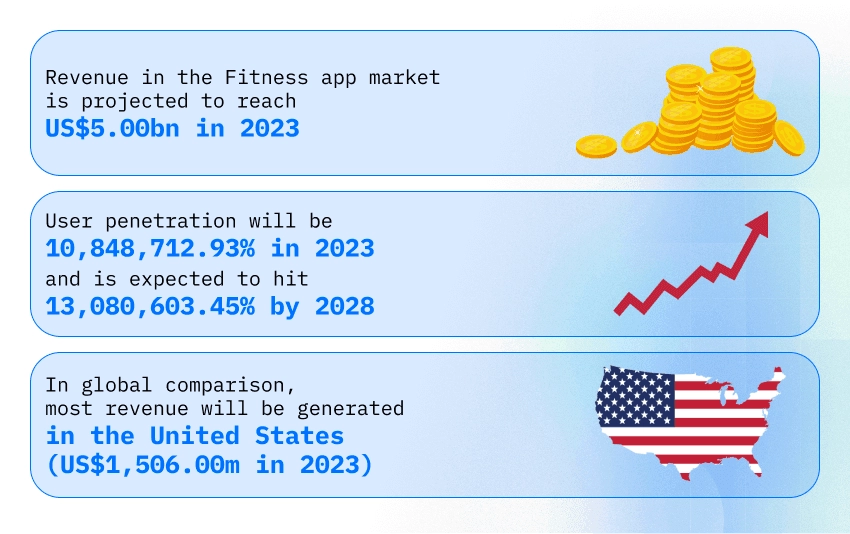
Businesses increasingly recognize the potential of personal fitness trainer apps to revolutionize user engagement and overall success. This shift is propelled by the fact that between 2024 and 2028, the worldwide count of smartphone users was projected to experience a steady increase, totaling an additional 496.7 million users (+10.71 percent), according to Statista. In this context, we delve into five compelling reasons businesses should consider developing their own Personal Fitness Trainer App, drawing inspiration from successful examples and industry trends. From increased accessibility to community building and monetization opportunities, these reasons underscore the transformative impact such apps can have on user experience and business growth.
Increased Accessibility and Convenience
Developing a Personal Fitness Trainer App allows businesses to offer fitness guidance and support to users anytime, anywhere. Users can access personalized workout plans, nutritional guidance, and progress tracking from the convenience of their smartphones. This accessibility encourages users to stay committed to their fitness goals, even when they cannot visit a physical gym or meet with a trainer in person.
Personalization for Enhanced User Engagement
A Personal Fitness Trainer App can utilize user data to create personalized workout routines and nutrition plans. By considering factors such as fitness level, goals, and health conditions, the app can tailor recommendations to meet individual needs. Personalization enhances user engagement, as individuals are more likely to stay motivated when their fitness journey feels customized to their specific requirements and preferences.
Real-time Progress Tracking and Feedback
The app can incorporate features for real-time progress tracking, allowing users to monitor their achievements and improvements. Additionally, incorporating feedback mechanisms, such as push notifications or in-app messages, enables trainers to provide timely encouragement, corrections, or adjustments to the user’s fitness routine. This instant feedback loop contributes to a sense of accountability and motivation, keeping users actively engaged in their fitness journeys.
Community Building and Social Integration
Integrating social features within the app, such as forums, challenges, or sharing options, create a sense of community among users. This community aspect fosters a supportive environment where individuals can share their achievements, challenges, and tips. Businesses can leverage this social integration to build brand loyalty, encourage user interaction, and even organize virtual events or challenges to enhance user engagement further.
Monetization Opportunities and Business Growth
Developing a Personal Fitness Trainer App opens up various monetization opportunities for businesses. This can include subscription models for premium features, in-app purchases for exclusive content or merchandise, and partnerships with fitness product brands. Furthermore, having a well-designed and user-friendly app can attract a more extensive user base, contributing to the overall growth and success of the business. Additionally, businesses can gather valuable user data, enabling them to refine their offerings and marketing strategies based on user behaviors and preferences.
Types of Personal Trainer Apps
Many personal training apps have emerged to cater to users’ diverse needs and preferences. From illustration-based guidance to immersive 3D models, these apps offer innovative approaches to fitness, encompassing exercise routines, nutrition planning, activity tracking, and mindfulness practices. Consider the distinct types of personal training apps with detailed descriptions and examples of renowned applications in each category. These apps collectively contribute to a holistic and personalized fitness experience, empowering users on their journey towards well-being.
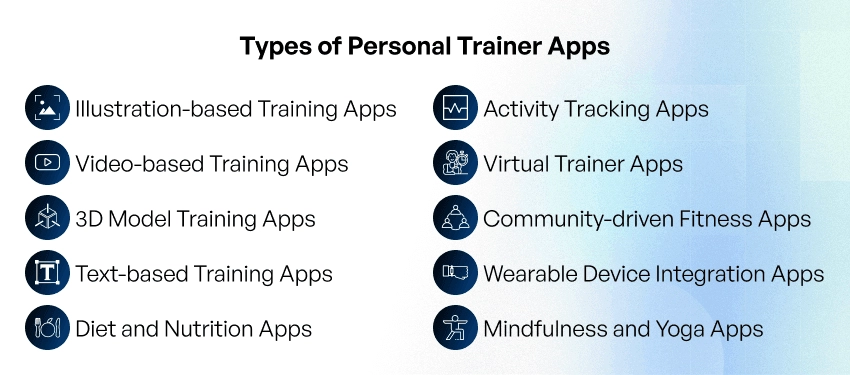
Illustration-based Training Apps
One notable category utilizes visual illustrations to guide users through exercises. An example in this domain is the Seven – 7 Minute Workout app, which employs animated illustrations to facilitate quick and effective workout routines. Users benefit from clear visual guidance for each exercise, enhancing their overall fitness experience.
Video-based Training Apps
Another prominent type relies on video demonstrations by fitness professionals to guide users through workout routines. FitOn is a prime example, offering a diverse array of video workouts led by certified trainers. This format allows users to follow real-time workouts and ensures proper form and technique.
3D Model Training Apps
For those seeking a more immersive experience, certain apps integrate 3D models to depict proper exercise form and technique visually. JEFIT stands out in this category, utilizing 3D animations to demonstrate precise workout visualization. This approach enhances users’ understanding of each exercise, contributing to a more effective fitness routine.
Text-based Training Apps
Some apps opt for a text-based approach, offering detailed written instructions for users to follow in their workout routines. An example is StrongLifts 5×5, which provides comprehensive text instructions for strength training programs. This format caters to users who prefer textual guidance in their fitness journey.
Diet and Nutrition Apps
Beyond exercise, certain apps focus on nutrition planning, meal tracking, and dietary guidance. MyFitnessPal is a widely recognized app in this category, allowing users to log meals and track their caloric intake. This holistic approach ensures users can manage their physical activity and nutritional habits on one platform.
Activity Tracking Apps
Activity tracking apps monitor and record various physical activities, offering insights into users’ daily movements. An example in this field is Strava, designed for tracking running, cycling, and other outdoor activities. Its social features foster community engagement, adding a communal aspect to fitness tracking.
Virtual Trainer Apps
Apps in this category utilize virtual trainers or AI algorithms to generate personalized user workout plans. Freeletics is a notable example, employing AI to create customized training programs based on individual goals and progress. This personalized approach enhances user engagement and motivation.
Community-driven Fitness Apps
Certain apps connect users, fostering a sense of community and enabling them to share achievements and participate in challenges. Fitbit is a prime illustration, promoting social interaction and friendly competition alongside activity and sleep tracking. This communal aspect adds a social dimension to the fitness journey.
Wearable Device Integration Apps
Some apps seamlessly integrate with wearable devices to track fitness metrics and provide a comprehensive overview. Garmin Connect is a noteworthy example, serving as a companion app for Garmin wearables. This integration ensures users receive in-depth insights into their physical activities and overall health.
Mindfulness and Yoga Apps
For those prioritizing mental well-being, certain apps focus on mindfulness, meditation, and yoga exercises. Headspace is renowned for offering guided meditation and mindfulness exercises, promoting stress reduction and relaxation. These apps contribute to a holistic approach to health and wellness by addressing physical and mental aspects.
The diverse landscape of personal training apps ensures that individuals can find the perfect fit for their unique fitness goals, preferences, and lifestyles.
Features of Personal Training Apps
Beyond the essential features, this paragraph explores advanced functionalities designed to elevate the user journey, leveraging augmented reality, biometric integration, live streaming, and gamification. These advanced elements enhance workout effectiveness and foster community and holistic well-being. For those with a discerning eye for a next-level fitness app, the following features delve into the cutting edge of personalized training and health monitoring.
User Authentication and Profiles
- Description: Implement a secure login system for users, allowing them to create and manage personalized profiles. This feature enhances user engagement and ensures data privacy.
- Example: Users can register with their email or social media accounts and create profiles with details such as age, fitness goals, and exercise preferences.
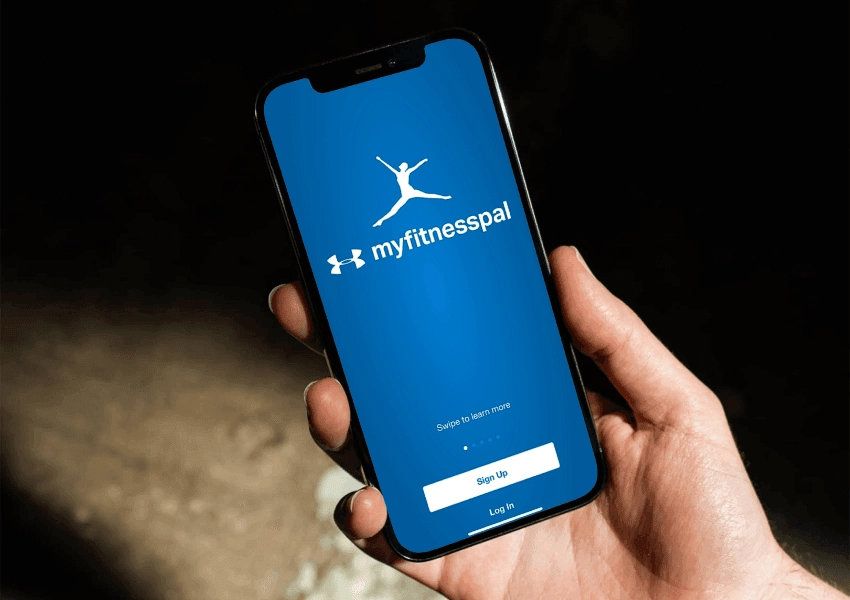
MyFitnessPal registration form
Workout Library with Varied Exercises
- Description: Include a comprehensive database of exercises with clear instructions and visuals. Users should have access to diverse workout options suitable for different fitness levels.
- Example: The app could feature categories like strength training, cardio, and flexibility, each with various exercises demonstrated through step-by-step instructions and videos.
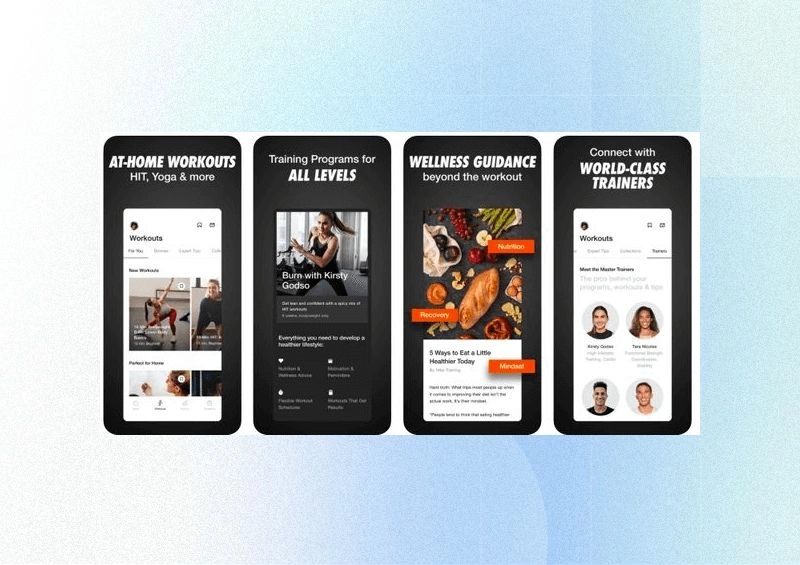
Nike Training Club
Personalized Workout Plans
- Description: Utilize AI algorithms or manual input to create personalized workout plans based on individual goals, fitness levels, preferred workout types, and available equipment.
- Example: After a user completes an initial assessment, the app generates a tailored workout plan that evolves as the user progresses, adapting to changing fitness levels and goals.

Nike Training Club beginner workout plan
Progress Tracking and Analytics
- Description: Provide tools for users to log and monitor their workout progress, set goals, and receive detailed analytics on performance metrics like calories burned, workout duration, and improvements over time.
- Example: Users can track their workout history, view graphical representations of their progress, and receive achievements for reaching specific milestones.
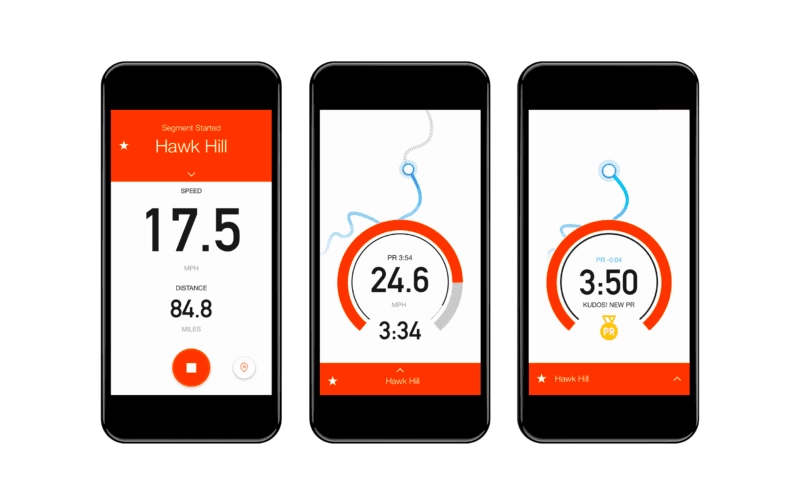
Strava app progress tracking
Nutrition Tracking and Guidance
- Description: Integrate features for users to log daily meals, track caloric intake, and receive nutritional guidance. This adds a holistic approach to health and fitness.
- Example: The app could offer a barcode scanner for food items, suggest personalized meal plans, and provide nutritional information for informed dietary choices.
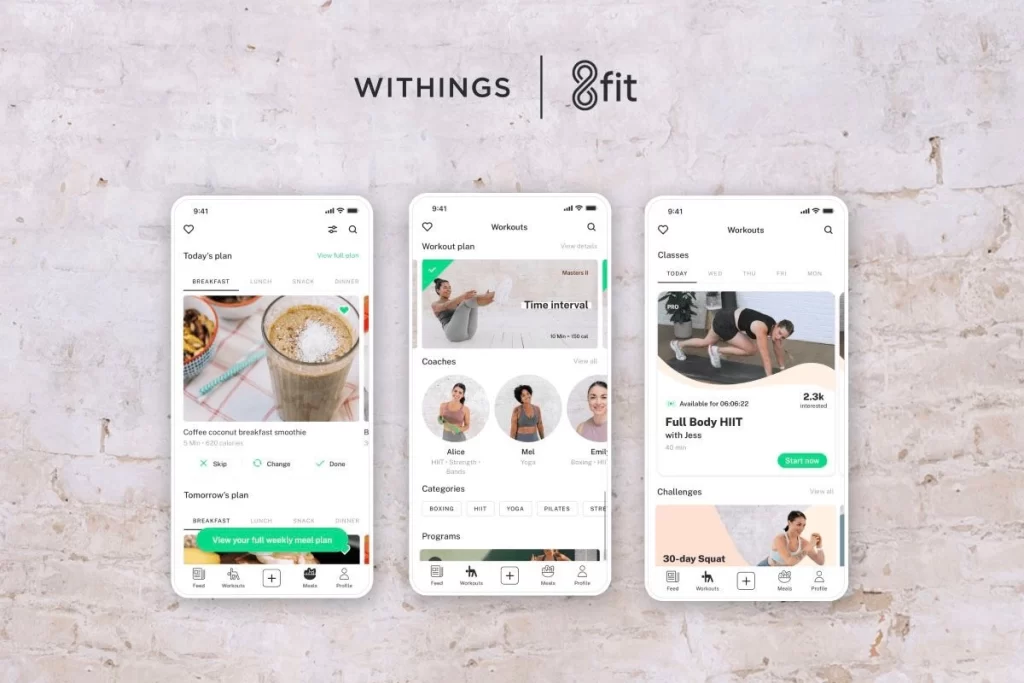
8fit nutrition guidance
Video Demonstrations
- Description: Include high-quality video content featuring fitness professionals demonstrating proper form and technique for each exercise. This ensures users perform workouts accurately.
- Example: Users can access a video library where certified trainers guide them through exercises, offering visual cues for correct execution.
Real-time Feedback and Virtual Coaching
- Description: Offer real-time feedback on users’ form, technique, and workout performance. Virtual coaching elements like voice instructions or visual cues enhance the user experience.
- Example: During a workout, the app provides instant feedback on posture and encourages users to optimize their movements for better results.
Community and Social Integration
- Description: Enable users to connect with fellow fitness enthusiasts, share achievements, participate in challenges, and receive support through in-app messaging or community forums.
- Example: A social feed allows users to post their workout achievements, join fitness challenges organized by the app, and connect with like-minded individuals for motivation and support.
Advanced features that are not critical but can make your app overcome competitors:
Augmented Reality (AR) Workouts
- Description: Integrate AR technology to create interactive and immersive workout experiences. Users can follow virtual trainers or engage in AR-enhanced workouts.
- Example: Users can use their phone cameras to project virtual trainers into their real-world environment, providing guidance and real-time feedback.
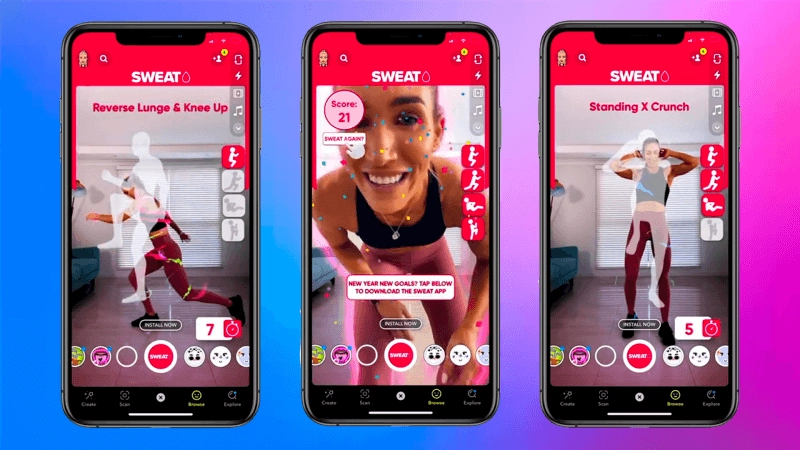
SWEAT Partners With Snapchat On AR Fitness Lens
Biometric Integration for Health Monitoring
- Description: Implement or integrate biometric sensors with wearable devices for real-time health monitoring. Track heart rate, oxygen saturation, and stress levels during workouts.
- Example: The app syncs with wearables or connects to Bluetooth-enabled health devices to give users a comprehensive overview of their physical well-being.
Gamification Elements
- Description: Incorporate gamified elements to enhance user motivation. Include challenges, rewards, and virtual badges to encourage consistent engagement.
- Example: Users earn points for completing workouts, achieving milestones, or participating in challenges, with the opportunity to unlock premium content or redeem rewards.
Integration with Health Apps
- Description: Integrate with broader health ecosystems, allowing seamless data exchange with electronic health records, telehealth platforms, or other health and wellness apps.
- Example: Users can share fitness data with their healthcare providers for more personalized health recommendations and insights.
Offline Access to Workouts
- Description: Enhance offline capabilities to allow users to download and access workout routines without an internet connection.
- Example: Users can download their personalized workout plans and access them during travel or in areas with limited connectivity.
These advanced features cater to a more sophisticated fitness experience, providing users with cutting-edge technology, personalized support, and a holistic approach to health and wellness.
Steps to Develop a Personal Trainer App
The development of a personal trainer app requires a strategic and thoughtful approach. From the initial conceptualization to the final launch, each step plays a pivotal role in shaping an app that meets its users’ needs and stands out in a competitive market. Below, we will walk through the seven critical steps in the development process, encompassing everything from defining objectives and conducting market research to designing an intuitive user interface, coding, testing, and executing a successful launch with a robust marketing strategy.
Step #1: Define Objectives and Target Audience
Before starting the development process, clearly articulate the objectives of your personal trainer app. Determine what purpose it serves and what goals it aims to achieve. Additionally, identify your target audience—whether it’s fitness enthusiasts, beginners, or individuals with specific health objectives. Understanding your app’s purpose and audience is crucial for guiding the development process.
Step #2: Market Research
Conduct comprehensive market research to gain insights into existing personal trainer apps and the overall fitness app landscape. Analyze competitor apps to identify strengths, weaknesses, and opportunities. Moreover, delve into the needs and preferences of your target audience. This research will help you identify unique selling points and design features that cater to the specific demands of your users.
Step #3: Conceptualization and Prototyping
Once you clearly understand your objectives and the market, begin conceptualizing your app. Define the core features and functionalities it will offer. Consider features such as personalized workout plans, exercise demonstrations, progress tracking, and user profiles. This step lays the foundation for the development process, guiding the creation of a feature set that aligns with your app’s purpose.
Step #4: Design UI/UX
Designing the user interface (UI) and ensuring a positive user experience (UX) is crucial for the success of your personal trainer app. Create wireframes and prototypes that outline the layout and flow of your app. Focus on making the design intuitive and user-friendly. Consider the visual aspects, ensuring the design aligns with your brand identity. A well-thought-out UI/UX enhances user satisfaction and engagement.
Step #5: Development
Choose a suitable technology stack for your app’s development. Break down the development process into iterations or sprints, starting with implementing essential features. As the development progresses, incorporate more advanced functionalities. Prioritize security measures, including secure user authentication and data protection. This step involves turning the conceptualized features into a functional app.
Read also about fitness app development in detail.
Step #6: Testing
Thorough testing is essential to ensure the reliability and functionality of your personal trainer app. Test the app on various devices and screen sizes to guarantee a consistent user experience. Identify and rectify any bugs or issues that may arise during testing. This step is crucial for delivering a polished and reliable app to your users.
Step #7: Launch and Marketing
Plan a strategic launch for your app, considering timing, target audience, and market trends. Implement a robust marketing strategy to promote your personal trainer app. Utilize channels such as social media, collaborate with influencers, and explore partnerships to increase visibility. A well-executed launch and marketing plan can significantly impact your app’s initial success and user adoption.
Cost to Develop a Personal Trainer App
The cost to develop a personal trainer app can vary widely based on several factors, including the complexity of features, platform (iOS, Android, or both), design requirements, and the development team’s location and expertise. Here’s a rough estimate of the development costs:
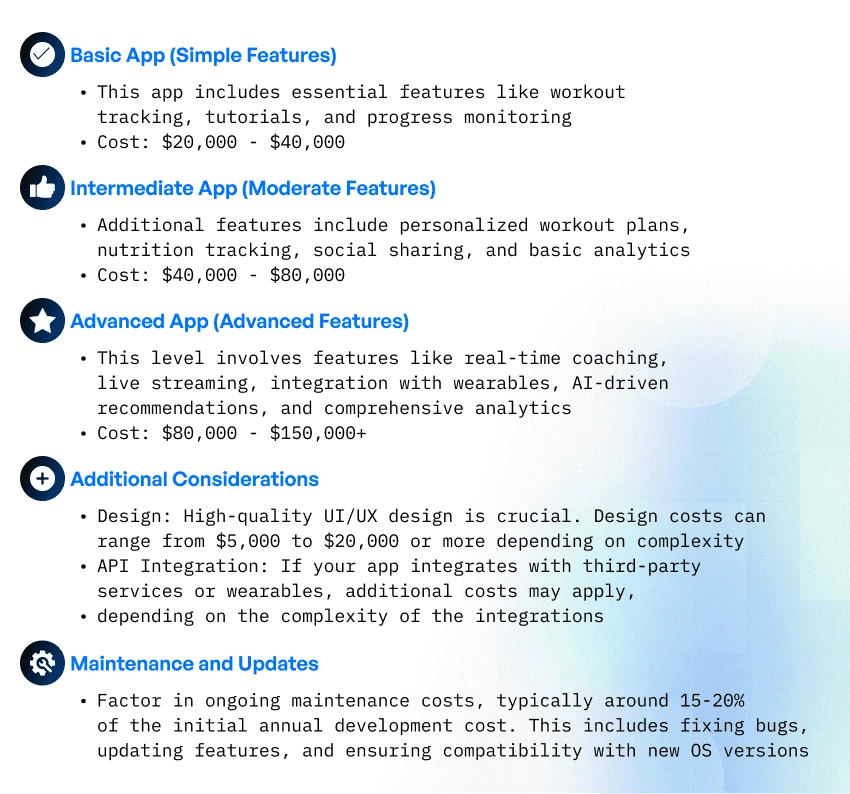
Basic App (Simple Features)
- This app includes essential features like workout tracking, tutorials, and progress monitoring.
- Cost: $20,000 – $40,000
Intermediate App (Moderate Features)
- Additional features include personalized workout plans, nutrition tracking, social sharing, and basic analytics. Also, it integrates seamlessly with various wearable devices such as fitness bracelets, smartwatches, heart rate monitors, and more. This inclusion expands its capabilities, allowing users to sync and utilize data from their wearable devices within the app. It sits at a mid-level tier compared to the Advanced App, which incorporates AI, streaming, and other advanced features.
- Cost: $40,000 – $80,000
Advanced App (Advanced Features)
- This level involves features like real-time coaching, live streaming, integration with wearables, AI-driven recommendations, and comprehensive analytics.
- Cost: $80,000 – $150,000+
Additional Considerations
- Design: High-quality UI/UX design is crucial. Design costs can range from $5,000 to $20,000 or more depending on complexity.
- API Integration: If your app integrates with third-party services or wearables, additional costs may apply, depending on the complexity of the integrations.
Maintenance and Updates
- Factor in ongoing maintenance costs, typically around 15-20% of the initial annual development cost. This includes fixing bugs, updating features, and ensuring compatibility with new OS versions.
Remember that these estimates are generalizations, and the actual cost can vary based on specific project requirements and the development team you choose. Additionally, the costs will be higher if you plan to launch the app on both iOS and Android platforms. Working with a reputable development team or agency that can provide a detailed project proposal and a breakdown of costs based on your specific app features and requirements is advisable.
The Best Ways to Monetize a Personal Trainer App
Monetizing a personal trainer app can be achieved through various strategies that provide value to users while generating revenue. Here are some practical ways to monetize a personal trainer app:
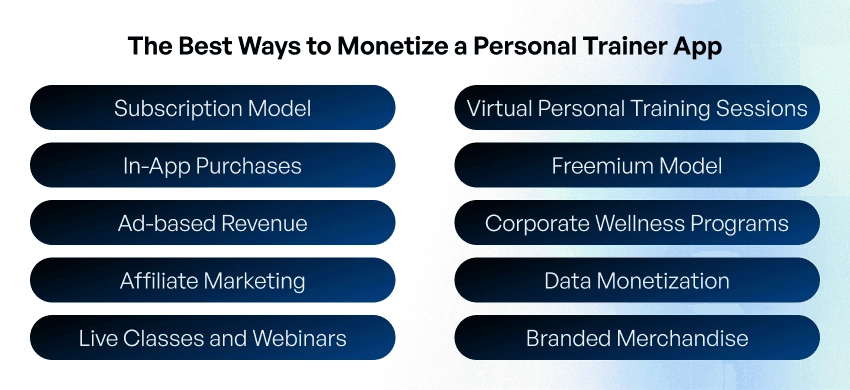
Subscription Model
- Offer a subscription-based model where users pay a monthly or annual fee to access premium features and personalized workout plans.
- Provide subscription tiers with varying access levels, such as exclusive content, advanced analytics, or live coaching sessions.
In-App Purchases
- Offer in-app purchases for additional workout plans, nutrition guides, or specialized training programs.
- Users can buy fitness equipment, apparel, or nutritional supplements directly through the app.
Ad-based Revenue
- Integrate non-intrusive ads within the app. Consider partnering with fitness-related brands to display targeted ads to users.
- Offer a premium, ad-free version for users who prefer an uninterrupted experience and charge a fee.
Affiliate Marketing
- Partner with companies that sell fitness products, supplements, or equipment and earn a commission for every sale made through your app.
- Integrate affiliate links seamlessly within your app, such as in recommended products or gear sections.
Live Classes and Webinars
- Offer live-streaming fitness classes or webinars led by certified trainers. Charge users to access these live sessions or include them in a premium subscription package.
- Allow users to purchase individual live classes or offer bundles for discounted rates.
Virtual Personal Training Sessions
- Provide a platform for users to book virtual one-on-one training sessions with certified personal trainers. Charge a fee for each session or offer package deals.
- Implement a scheduling and payment system within the app to streamline the process.
Freemium Model
- Provide a free version of the app with essential features and limited access to content. Encourage users to upgrade to a premium subscription for an enhanced experience.
- Use the free version to attract a more extensive user base and upsell premium features.
Corporate Wellness Programs
- Partner with companies to offer your app as part of their employee wellness programs. Charge a corporate rate for bulk user access.
- Provide features like team challenges, leaderboards, and progress tracking to encourage workplace fitness.
Data Monetization
- Aggregate anonymized and consented user data to provide insights to fitness brands, researchers, or healthcare providers.
- Ensure strict privacy policies and transparent communication with users regarding data usage.
Branded Merchandise
- Create and sell branded merchandise within the app, such as workout apparel, water bottles, or fitness accessories.
- Offer exclusive discounts on merchandise for premium subscribers.
When implementing these monetization strategies, balancing generating revenue and providing value to your users is crucial. Regularly update and improve your app based on user feedback to enhance the overall user experience and increase user retention.
Alternative Spaces Expertise in Personal Trainer App Development
Ensuring the success of your personal trainer app’s success hinges on your development team’s expertise. At Alternative Spaces, with over two decades of experience in software development, we specialize in crafting custom mobile applications for Android and iOS platforms and wearables. Our team of seasoned professionals offers a comprehensive suite of development services tailored for startups, small enterprises, and medium-sized businesses worldwide. We’re equipped to seamlessly manage your fitness app project, aligning with your approved requirements and budget. Furthermore, we assist in harnessing the latest technologies to align with evolving market trends or your unique business objectives. Now, explore our proficiency in mobile fitness application development through a notable project:
A team of seasoned swimmers and coaches conceptualized Phlex, an innovative swimming workout app. The app is designed to elevate users’ swimming techniques and overall performance. Alternative Spaces took charge of this project by overhauling the outdated iOS codebase and constructing an entirely new Android application. Our professionals excelled in redesigning the app’s interface and user experience, prioritizing a simple yet captivating design to attract and retain users effectively.
Beyond the development of intuitive mobile applications, we extended our expertise to create an Apple Watch companion tracking app. Ensuring practical data synchronization between the app and wearable devices, Phlex stands today as a reliable, high-performance mobile application, enhancing the efficiency and enjoyment of swimming workouts. Trust Alternative Spaces to transform your fitness app vision into a reality, where innovation meets functionality seamlessly.
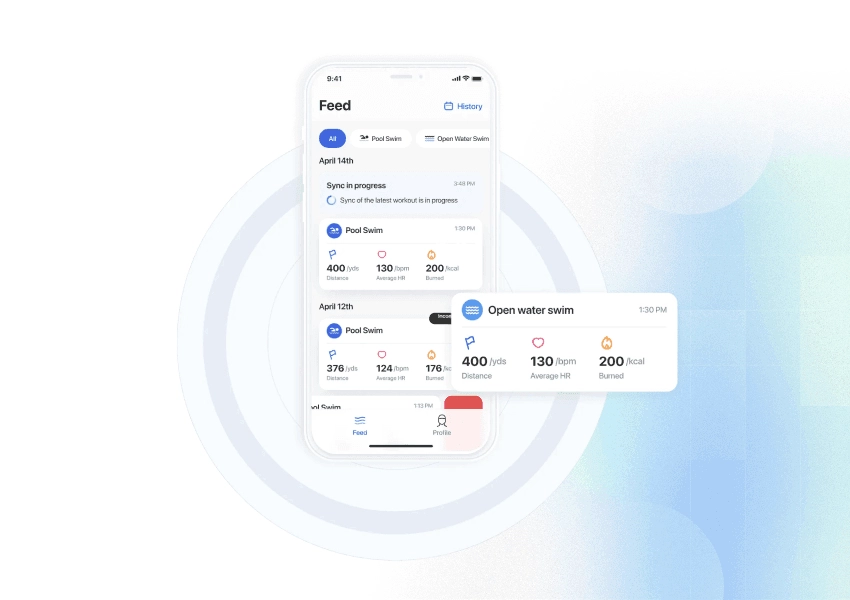
One more project is Clubhouse. Clubhouse is a cutting-edge online platform providing unparalleled access to various virtual fitness classes and workout videos. We developed a sports and fitness app to transform users’ daily habits, foster strength and muscle definition, and promote overall fitness. Clubhouse Fitness has swiftly become a highly coveted online fitness platform, offering users unprecedented opportunities to engage with exceptional trainers and instructors. The website modestly attracted 100 users over six months in its previous iteration. However, with Alternative Spaces’s expert craftsmanship, the revamped version experienced a remarkable surge, drawing in 350 new users within just 1.5 months of its release. This substantial growth is a testament to the transformative impact of Alternative Spaces’s enhancements, propelling our client to unprecedented success in the online fitness arena.

In conclusion
In summary, navigating the intricate development journey of a personal trainer app underscores the importance of choosing the right technology partner. The app’s success hinges on the expertise, experience, and innovation brought to the table by the development team. In this context, Alternative Spaces emerges as an exceptional choice, boasting over two decades of experience in software development. As the fitness industry continues to evolve, aligning with a trusted partner like Alternative Spaces ensures a functional app and an innovative, user-centric platform that empowers individuals on their health and wellness journeys. So, contact us to get a free consultation on personal trainer app development and we’ll be glad to collaborate with you.
FAQ
Q: What considerations should be made when choosing the technology stack for a personal trainer app?
A: When selecting a technology stack, factors such as the app’s functionalities, scalability, and target platforms (iOS, Android) are crucial. Choosing the right programming language, frameworks, and databases ensures optimal performance.
Q: How can security measures be integrated into the development process of a personal trainer app?
A: Implementing encryption protocols for user data, secure authentication methods, and regular security updates are essential. Ensuring data protection measures are in place safeguards user information and builds trust.
Q: What are the key challenges in developing a cross-platform personal trainer app?
A: Challenges may include ensuring consistent user experience across different platforms, optimizing performance for varied devices, and addressing platform-specific nuances. Choosing the right cross-platform development tools is critical to overcoming these challenges.
Q: How can integrating gamification elements enhance user engagement in a personal trainer app?
A: Gamification elements such as badges, rewards, and challenges can make workouts more enjoyable and motivate users to stay consistent. Integrating these elements into the app design can boost user engagement and retention.
Content created by our partner, Onix-systems.
Source: https://onix-systems.com/blog/personal-trainer-app-development-guide Home
Home
